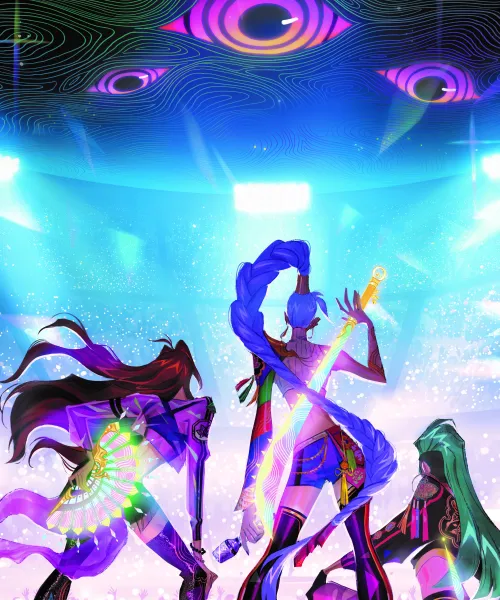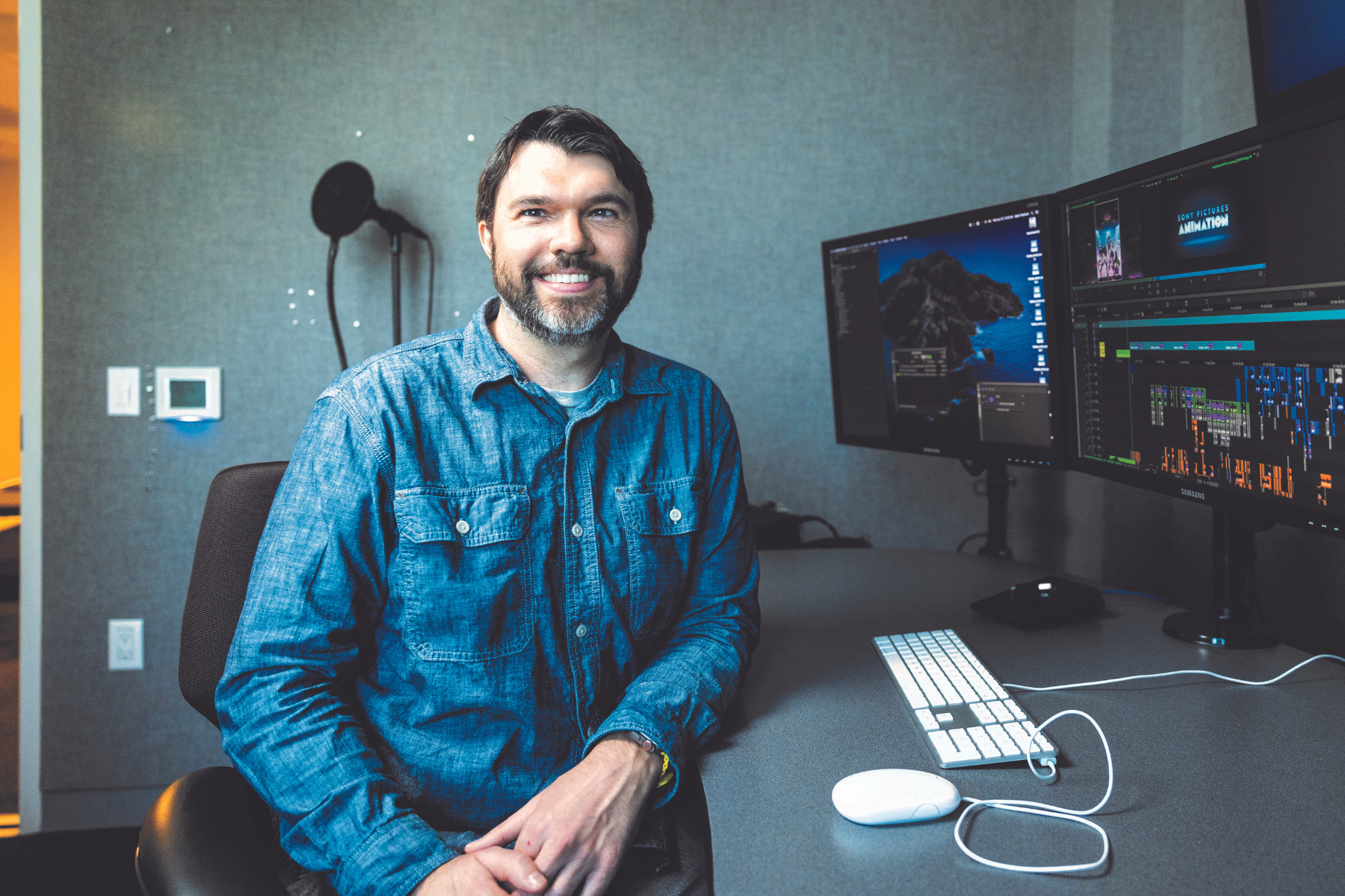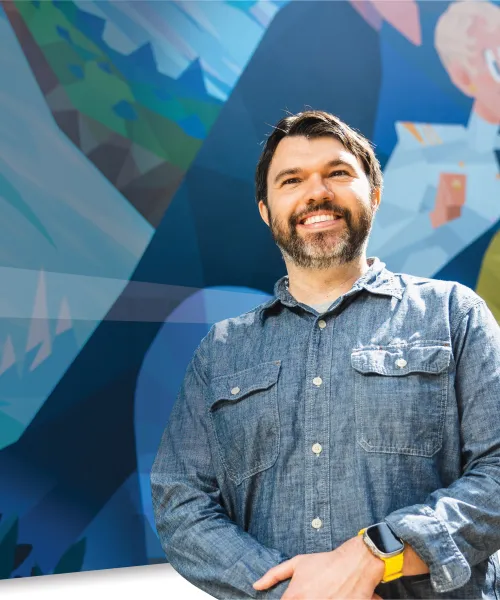By Kristi Evans
At the urging of an editor he met shortly after arriving in Los Angeles 16 years ago, Gabriel Thorburn ’07 BFA joined the team at Sony Pictures Animation last year to serve as associate editor on a feature film currently in development titled K-Pop: Demon Hunters. The musical action adventure follows members of a world renowned Korean Pop (K-Pop) girl group “as they balance their lives in the spotlight with their secret identities as bad-ass demon hunters.” It is set against a colorful backdrop of fashion, food, style and the signature sound of arguably this generation’s hottest music movement. The film rides the swelling wave of global interest in Korean culture and entertainment.
“K-Pop is really great to work on as an editor because there’s a good variety of action, drama, comedy and musical numbers, and we’re actively helping to bring all those elements together in a way that brings the story to life,” said Thorburn, who earned a digital cinema degree from NMU. “During the story phase of K-Pop, we are taking the sketches created by storyboard artists and editing them into animatic with dialogue, sound effects and music for the directors. While editing the animatic, I also work as an actor in a sense, timing out the storyboards and the characters’ emotions with each other on screen. Theater classes I took at Northern came in handy for that.
“Editors are really the first audience members of a movie. Once we finish editing a first pass at a scene, we sit back and watch it as an audience member and decide if it’s working or not. Sony is a unique studio to work for. It’s refreshing that there’s more of an emphasis here on original ideas and content, like K-Pop. You know you really love a job when the day ends, and you want to keep on working because you’re having fun.”
Animated films take anywhere from two to five years to produce, said Thorburn, noticeably longer than most live action projects. He is contracted with the studio for the duration of K-Pop: Demon Hunters’ development, currently working a hybrid schedule split between his home office and the Sony Pictures Animation complex in Culver City, California.

Thorburn accompanied Northern Magazine staff members on a walk of the studio grounds in search of a photo shoot location. For some shots, he stood in front of a colorful mural painted on a curved concrete structure by Carlos Zaragoza. It features a collage of animated stars from throughout the studio’s 21-year history, including the Smurfs and Hotel Transylvania characters. There is also a depiction of the Marvel superhero at the center of the 2019 Academy Award-winning Best Animated Feature, Spider-Man: Into the Spider-Verse. The highly anticipated sequel, Spider-Man: Across the Spider-Verse, was released June 2.
The Sony opportunity surfaced when Thorburn was between jobs and putting out feelers. He had spent a year at Skydance Media, working remotely full time on the movie Luck for AppleTV+. Prior to that, he served as an online editor at DreamWorks Animation in Glendale, California. Thorburn collaborated on projects such as the Netflix series’ Dragons: Race to the Edge and the Tales of Arcadia trilogy, which includes Trollhunters, 3Below and Wizards.
“Online editing occurs during the final phase of post-production, when the movie’s basically done, but requires very minor fixes,” he said. “Once the final lighting phase was complete, I took the lower-resolution footage and increased the resolution to the highest quality. Then I married the final sound mix with the final color-corrected picture before sending it to Netflix.”
In 2016, Thorburn worked briefly as an additional editor for Dear Dictator, a live action, independent film starring Michael Caine. “I came on and helped edit the dailies they shot and completed the early phase of cutting scenes together. A lot of what I worked on ended up staying in the movie.”
He previously worked as a second assistant editor on another live action feature film, Jonah Hex, for Warner Bros. Pictures in 2009. Four years later, he was hired by Warner Bros. Animation. He served as online editor for Teen Titans Go!, The Looney Tunes Show, The Tom and Jerry Show and Beware the Batman. He also was assistant editor for Right Now Kapow, DC Super Heroes and Be Cool, Scooby-Doo!
Despite the prevalence of Artificial Intelligence (AI) and concerns expressed about its potential to overhaul the typical creative process, Thorburn said the technology has not yet entered his postproduction realm. He has experimented with it a bit at home, but questions whether it would be capable of editing better than a person in its current form. “Human editors make thousands of micro split-second decisions every minute relating to human emotions and life experience, which would be really difficult for a machine to do right now. The creativity we use while editing comes from a spiritual place—from our hearts and life experiences—as we help bring a movie to life.”

It was in his hometown of Marquette that Thorburn’s career goal was cultivated. He always loved animation as a kid, and dreamed of working in the industry. During his senior year of high school, an internship at the former Superior Productions video production company on Third Street introduced him to editing. Thorburn said he sat down at a computer with nonlinear editing software one day, put together an event video and was hooked. His NMU education, along with a part-time job he held during that time at the former Video Concepts, solidified his aspiration to become an editor. After he graduated and moved to Los Angeles, he found assistant editor positions an effective gateway to that line of work.
“I really enjoyed that. It’s more the technical side of things as opposed to creative editing, yet it’s still creative because you’re using technical problem-solving skills to troubleshoot issues that come up, and you’re finding ways to streamline the work flow pipeline to make things work effectively.”
For those who may be interested in working in the TV or film industries, Thorburn advises them to develop a clear vision of what they really want to do, create a plan and follow through on it.
“Just start meeting people where you want to live, whether L.A. or a different market. Once you start meeting a few people, you’ll have enough contacts to last your career. When I came out here, there was a demand for Final Cut Pro editors, but not a lot of people trained in it. I became proficient when I was at Northern, and I got a lot of work from that in California. I was an FCP assistant on one project shortly after my move here. The editor I worked with on that project kept in touch over the years, and he’s the one who reached out to me to join him on K-Pop.”
Thorburn credits his Northern education for preparing him for professional success. At NMU, he said, “It was the same culture you find in an animation studio: lots of artists around, talking about things and hearing things described in a visual way, which was very helpful. I loved the final course in the digital cinema concentration that Daric Christian taught, where you make a film every week. That really put all of us on a creative path. With my minor in film studies, I also found Marek Haltoff’s film classes incredible.”
Photography is another skill Thorburn gained during his time at NMU. Once settled in California, he became an avid camper, exploring the state’s National Parks with his 1970's Canon AE1 35mm camera or medium-format Hasselblad and an ample supply of film (no digital for him).
Thorburn exhibited some of his photography—primarily landscape and nature images—at a 2018 DreamWorks art fair for employees. He had “an existential crisis with photography” more recently, when a company stopped producing his favorite type of film. But he also said he hasn’t had much time to pursue the hobby as of late. He’s too busy having fun with his rewarding career at Sony Pictures Animation.
